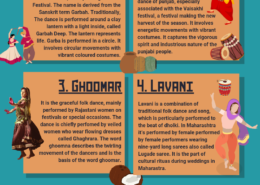Talk about the part that community involvement plays in folk dance. How does this continuity and pride in culture across generations get fostered by this inclusivity?
Festivals and celebrations play a crucial role in promoting folk dances, acting as vibrant platforms for community bonding and cultural preservation. Here’s an analysis of their significance: 1. Cultural Expression and Performance Showcase of Heritage: Festivals provide an opportunity for communitieRead more
Festivals and celebrations play a crucial role in promoting folk dances, acting as vibrant platforms for community bonding and cultural preservation. Here’s an analysis of their significance:
1. Cultural Expression and Performance
- Showcase of Heritage: Festivals provide an opportunity for communities to showcase their folk dances, allowing participants to express their cultural identity through music, movement, and traditional attire.
- Diverse Participation: These events often involve people of all ages, fostering intergenerational participation and ensuring that cultural practices are passed down through generations.
2. Community Bonding
- Collective Participation: Festivals encourage collective engagement, bringing together individuals from various backgrounds within a community. This shared experience strengthens social ties and fosters a sense of belonging.
- Strengthening Relationships: Collaborative preparations for festivals, including dance practices and organizing events, enhance relationships among community members, promoting teamwork and camaraderie.
3. Ritual Significance
- Cultural Rituals: Many folk dances are integral to religious or seasonal rituals celebrated during festivals. This spiritual connection adds depth to the performances and reinforces cultural values.
- Cycle of Life: Festivals often mark important life events (harvest, marriage, religious observances) and involve folk dances that celebrate these milestones, underscoring the community’s connection to nature and tradition.
4. Cultural Preservation
- Transmission of Traditions: Festivals serve as platforms for teaching younger generations about traditional folk dances, ensuring cultural practices are not lost over time. Workshops and performances help instill pride in heritage.
- Documentation and Continuity: Regular celebration of folk dances during festivals helps document and preserve these art forms, maintaining their relevance in contemporary society.
5. Economic and Social Impact
- Local Economy: Festivals often attract tourism, providing economic benefits to local communities. This financial support can help sustain traditional art forms, including folk dance, by funding workshops and training programs.
- Cultural Tourism: By promoting folk dances during festivals, communities can attract visitors interested in cultural experiences, further enhancing awareness and appreciation of their traditions.
6. Intercommunity Exchange
- Cultural Sharing: Festivals can also facilitate cultural exchange between different communities. By inviting diverse groups to participate, folk dances become a medium for dialogue, mutual respect, and understanding among various cultural identities.
- Unity in Diversity: Celebrations that feature multiple folk dance forms from different regions promote the idea of unity in diversity, highlighting the rich tapestry of Indian culture.
Conclusion
In conclusion, festivals and celebrations are vital for promoting folk dances, serving as dynamic events that strengthen community bonds and contribute to cultural preservation. Through collective participation and ritual significance, these events not only celebrate heritage but also ensure the transmission of traditions to future generations. They play a pivotal role in maintaining the vibrancy of folk dances while fostering social cohesion and cultural identity within communities.
See less

Community participation plays a vital role in folk dance, serving as a foundational element that fosters cultural pride and ensures continuity across generations. Here’s an exploration of how this inclusivity impacts communities: 1. Shared Experience and Collective Identity Cohesion and Bonding: ComRead more
Community participation plays a vital role in folk dance, serving as a foundational element that fosters cultural pride and ensures continuity across generations. Here’s an exploration of how this inclusivity impacts communities:
1. Shared Experience and Collective Identity
2. Intergenerational Learning
3. Cultural Pride and Heritage
4. Emotional and Social Well-Being
5. Preservation of Language and Rituals
Conclusion
In summary, community participation in folk dance is essential for fostering cultural pride and continuity among generations. By encouraging inclusivity and collaboration, folk dance strengthens social bonds, facilitates the transmission of traditions, and promotes a vibrant cultural identity. This participatory nature not only enriches individual lives but also ensures that the community’s heritage remains dynamic and relevant, creating a living tradition that thrives through collective effort and shared joy.
See less